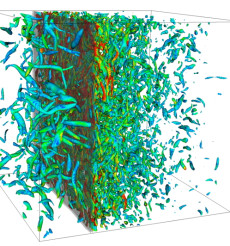Compressible Turbulence and Interactions with Shock Waves and Material Interfaces
Alternate Title: High-fidelity simulations of supersonic turbulent mixing and combustion
Key Challenges: Direct numerical simulation (DNS) of isotropic turbulence interacting with a normal shock wave and turbulent multi-material mixing in the Richtmyer-Meshkov instability (RMI)
Why it Matters: Shock/turbulence interaction is a fundamental phenomenon in fluid mechanics that occurs in a wide range of interesting problems in various disciplines, including supernova explosions, inertial confinement fusion, hypersonic flight and propulsion, and shock wave lithotripsy.
Accomplishments: A novel solution-adaptive algorithm that applies different numerics to discontinuities and broadband turbulence has been used on NERSC's Cray XT4 supercomputer. The simulations capture a shock while directly resolving all scales of turbulence and show that DNS requires a refined grid in both the shock normal and the transverse directions to fully resolve the viscous scales of turbulence. The NERSC supercomputing resources allowed sufficiently fine-grid calculations to ensure fully developed isotropic turbulence upstream of the shock and suggest that previous DNS studies of this problem
were under-resolved in the postshock region.
Investigators: Sanjiva Lele, Johan Larsson, and Eric Johnsen (Stanford University)
More Information: See Phys. Fluids 21, 126101 (2009) and the Stanford SciDAC Simulations of Turbulent Flows with Strong Shocks and Density Variations Science Application web site.








